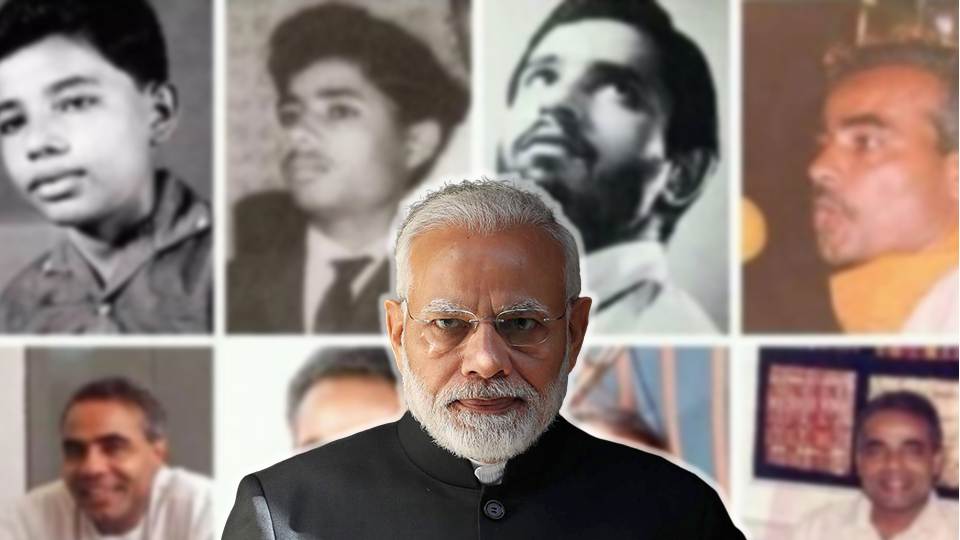Narendra Modi journey: PM Narendra Modi is an eternal optimist. Amid the dark times of Covid pandemic, he gave a clarion call to build a resilient Aatmanirbhar Bharat. Initially, it was a bold target beyond the normal growth trend but the final result is before everyone to see. In fact, optimism and trust in him was visible from his initial days of coming to power.
Without the prior first-hand experience of governance and administration, he heralded earthquake-wrecked Gujarat to new highs. The same continued after 2014 and defence importer – India took a small but decisive step in export of defence hardware among other such landmark successes.
Here, we will highlight the backstory about the rise of Narendra Modi on the political landscape and how he relentlessly scripted history.
Narendra Modi journey – History in the making
On the 7th of October, 2001, Narendra Modi was sworn in as the Chief Minister of Gujarat. After that politics changed completely. He went on to become the longest-serving CM of the state. He served as Gujarat CM for more than 12 years over four terms. He popularised his style of politics, model of speedy governance, reform, development and last mile delivery of welfare schemes.
Coincidentally, he was the 14th person to be sworn in as the Gujarat CM. In 2014, he became the 14th person (excluding acting PM) to become the Prime Minister.
Also Read: Akshardham Temple attack: The terror attack that marked the turning point for Narendra Modi
With a combined tenure as Prime Minister and Chief Minister, he is one of the longest-serving heads of elected government in India. By the end of this term in May 2024, he would surpass Dr. Manmohan Singh in terms of tenure as Prime Minister.
However, to surpass former PMs Jawaharlal Nehru and Indira Gandhi, he would have to get elected again and stay in power beyond March 2031. But contrary to Dr Singh and Indira Gandhi, PM Modi has never lost any election, a feat comparable with Former PM Jawaharlal Nehru.
BJP leader Narendra Modi has won all assembly elections or bypolls he contested in Gujarat. Later, he won the two Lok Sabha elections in 2014 and 2019.
Backdrop of Narendra Modi becoming the Gujarat CM
Two stark stories were running in parallel in BJP during the late 90s and early 2000s. Veteran leader and then Gujarat CM Keshubhai Patel had gone past his prime. He had a long association with all the predecessors of BJP and its parent ideology, RSS. His popularity and administrative control was fast diminishing. He had served as Gujarat CM in 1995 and from 1998 to 2001. Moreover, his health was getting worse.
Also Read: Narendra Modi and Amit Shah: The friendship that changed the Indian politics
On the other hand, Narendra Modi was on the upswing. He had impressed BJP top leadership including Former PM Atal Bihari Vajpayee. Following the 1995 assembly election in Gujarat, BJP top leadership called Modi to New Delhi. He was made BJP National Secretary with responsibility for party activities in Haryana and Himachal Pradesh.
From Delhi, he played a major role in the mid-term polls held in Gujarat in 1998. He had a major say in the selection of the candidates. Former PM Vajpayee was very impressed by his election strategy-making in both 1995 and 1998 elections.
Former PM Atal Bihari Vajpayee entrust him the duty of Gujarat CM
The catastrophic earthquake in Bhuj, Gujarat on the Republic Day in 2001 forced BJP top brass to hold a serious discussion over the two contrasting stories and a possible change of guard in Gujarat.
With this backdrop, BJP leader Narendra Modi received a message from the then Prime Minister Atal Bihari Vajpayee to reach his 7, Race Course Road (now 7, Lok Kalyan Marg) as quickly as possible. Even before Modi could make himself comfortable, PM Vajpayee asked him to leave Delhi and head back to Gujarat.
Although, BJP leader LK Advani and others had their concerns, they didn’t want to sideline and upset Kesubhai Patel. Till then Narendra Modi had virtually no experience in government, and they asked Modi to become Deputy CM in Keshubhai Patel government. But trusting his own capabilities, he assured the leadership that lack of experience will not hinder the path of state’s development. He stressed that he would either take full responsibility of Gujarat or none at all. This is how Journey of leader Narendra Modi began.
Side-lining all doubts and concerns, Former Prime Minister Atal Bihari Vajpayee played the catalyst that made Narendra Modi the CM of Gujarat.
After winning a clear majority, the state governor, on October 4, 2001, invited Gujarat CM-designate Narendra Modi to form the government. Later, on 7th of October, 2001, Narendra Modi took oath as the Gujarat Chief Minister replacing Keshubhai Patel.
Now CM of Gujarat Narendra Modi had the responsibility of preparing the BJP for the December 2002 elections. On 24 February 2002, he won a by-election from a constituency in Rajkot and went on to create history. After that, he never looked behind and is only creating new successes for his party.
Today, on the 7th of October, 2022, PM Modi has completed 21 uninterrupted years of being in politics while holding constitutional posts. Furthermore, the way things are poised the run-up to Lok Sabha elections 2024 are well stacked in his favour.
Support TFI:
Support us to strengthen the ‘Right’ ideology of cultural nationalism by purchasing the best quality garments from TFI-STORE.COM
Also Watch:
